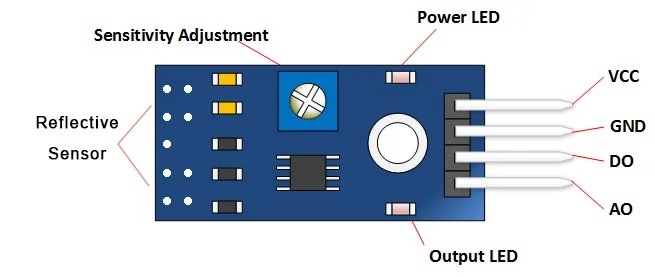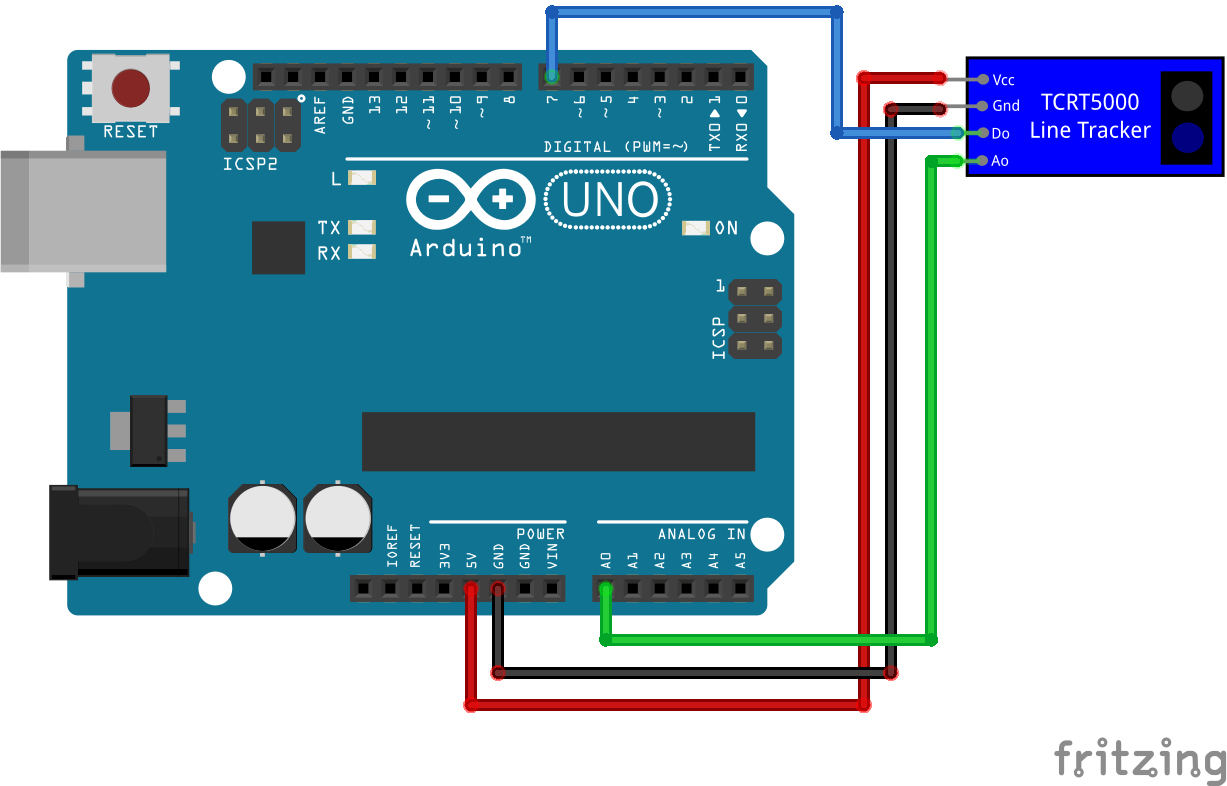AED 9.45
Description
The Line Follower 1 Channel Infrared Tracking Detection Sensor TCRT5000 is a small sensor module that uses infrared reflection sensors to detect the presence of a surface. It can detect a reflection distance between 1mm to 25mm and has a comparator output with a strong driving ability of more than 15 mA. The sensitivity of the sensor can be adjusted using a precision potentiometer. It has a working voltage of 3.3V to 5V and outputs a digital switch signal (0 or 1). The module has a fixed bolt-hole for convenient installation and a small PCB size. The sensor module uses the LM393 voltage comparator and operates with a wide voltage range.
Package Includes:
- 1 x Line Follower 1 Channel Infrared Tracking Detection Sensor TCRT5000
Features:
- Small infrared reflection sensor module for detecting reflective surfaces or objects
- Contains an infrared LED and a phototransistor for detecting the amount of reflected light
- Has both digital and analog output signals
- The digital output provides a simple on/off signal based on the amount of reflected infrared light
- Analog output provides a varying voltage signal that is proportional to the amount of reflected light for more precise measurements
- Sensitivity can be adjusted using a potentiometer for fine-tuned detection
- Operates on a voltage range of 3.3V to 5V
- Test reflection distance of 1mm to 25mm
- Comparator output provides a strong signal with a driving ability of more than 15mA
- Small PCB size with a fixed bolt hole for easy installation
- Uses the LM393 voltage comparator for reliable operation in harsh environments
- Highly versatile and adjustable sensor module suitable for a wide range of applications
Description:
The TCRT5000 is a small infrared reflection sensor module that can be used to detect the presence of reflective surfaces or objects. The module contains both an infrared LED and a phototransistor, which work together to detect the amount of reflected light. The TCRT5000 has both digital and analog output signals. The digital output provides a simple on/off signal that switches from 0 to 1 (or vice versa) based on the amount of reflected infrared light. The analog output provides a varying voltage signal that is proportional to the amount of reflected light. This allows for more precise measurements of the amount of reflected light, making it ideal for applications that require fine-tuned sensitivity. The module's sensitivity can be adjusted using a potentiometer. This allows the user to set the threshold at which the digital output switches based on the amount of reflected light. It also affects the level of the analog output signal. The TCRT5000 operates on a voltage range of 3.3V to 5V and has a test reflection distance of 1mm to 25mm. The module's comparator output provides a strong signal with a driving ability of more than 15mA, which means it can be used to directly drive other electronic devices. In addition to its versatile output signals, the TCRT5000 module is also easy to install and integrate into projects. It has a small PCB size of 3.2cm x 1.4cm and a fixed bolt-hole for convenient installation. The module uses the LM393 voltage comparator, which is a widely used and reliable comparator. The comparator has a wide voltage range and can operate in harsh environments.
Principle of Work:
The TCRT5000 module works based on the principle of infrared reflection. The module contains an infrared LED and a phototransistor, which are positioned opposite each other on the module. When the infrared light emitted by the LED hits a reflective surface, some of the light is reflected back to the phototransistor. The amount of reflected light detected by the phototransistor depends on the reflectivity of the surface and the distance between the sensor and the surface. The TCRT5000 module converts the amount of reflected infrared light into an electrical signal that can be output as either an analog or digital signal. The analog output provides a voltage signal that is proportional to the amount of reflected light, while the digital output provides a simple on/off signal based on a predetermined threshold. The analog output is implemented by converting the output from the phototransistor into a voltage signal using a voltage divider circuit, which consists of a fixed resistor and a variable resistor (the potentiometer). The variable resistor adjusts the sensitivity of the module, which affects the level of the analog output signal. The output voltage can be read by an analog-to-digital converter (ADC) in a microcontroller or other electronic device. The digital output is implemented using a comparator circuit, which compares the output voltage from the voltage divider circuit to a fixed reference voltage. When the output voltage exceeds the reference voltage, the comparator output switches from low to high (or vice versa), providing a digital signal that can be read by a microcontroller or other electronic device. The threshold at which the comparator switches can be adjusted using the potentiometer, allows the user to fine-tune the sensitivity of the module.
Pinout of the Module:

- VCC: The power input pin. Connect this pin to a regulated voltage source between 3.3V and 5V.
- GND: The ground pin. Connect this pin to the ground of the power supply.
- DO The digital output pin. This pin provides a digital on/off signal based on the amount of reflected infrared light. When the amount of reflected light exceeds the threshold set by the potentiometer, the output is HIGH (logic 1), otherwise it is LOW (logic 0).
- AO: The analog output pin. This pin provides an analog voltage signal that is proportional to the amount of reflected infrared light. The voltage range of the analog output is typically between 0V and VCC, with a maximum output current of 20mA.
- VCC and GND pins are connected to the onboard LM393 comparator chip and to the LED and phototransistor.
- The small potentiometer on the module allows the user to adjust the sensitivity of the sensor module. By turning the potentiometer, the threshold level for the digital output can be adjusted, and the sensitivity of the analog output can be fine-tuned.
Applications:
- Line following robots: The TCRT5000 module can be used to detect lines or tracks on a surface and help guide a robot along a predetermined path.
- Object detection: The module can be used to detect the presence or absence of objects on a reflective surface, making it useful for detecting obstacles, traffic flow, and other moving objects.
- Proximity sensing: The module's ability to detect reflective surfaces at distances ranging from 1mm to 25mm makes it useful for proximity sensing applications, such as detecting the presence of a hand near a dispenser or touchless control of home appliances.
- Industrial automation: The module can be used in industrial automation applications for detecting the position of parts on a conveyor belt or for detecting the level of liquids in a tank.
- Security systems: The module can be used to detect motion in a specific area by reflecting infrared light off of surfaces and detecting any changes in the reflected light pattern.
- DIY projects: The TCRT5000 module is a popular sensor for hobbyists and DIY enthusiasts who want to build their own robots, smart devices, or other electronic projects that require reflective surface detection.
Circuit:

- Connect the VCC pin on the module to a 3.3V to 5V power supply.
- Connect the GND pin on the module to the ground of the power supply.
- Connect the DO pin on the module to a digital input pin on the Arduino (e.g. pin 7).
- Connect the AO pin on the module to an analog input pin on the Arduino (e.g. pin A0).
Library:
No need for a library to work with this module.
Code:
The last code I provided is a simple Arduino sketch that reads the digital and analog output values from the Line Follower 1 Channel Infrared Tracking Detection Sensor TCRT5000 module and prints them to the serial monitor. This code can be useful for testing the Line Follower 1 Channel Infrared Tracking Detection Sensor TCRT5000 module and verifying that it is working properly, as well as for understanding the relationship between the analog and digital output values of the sensor.
const int DO_PIN = 7; // Digital output pin connected to DO pin on the module
const int AO_PIN = A0; // Analog output pin connected to AO pin on the module
void setup() {
pinMode(DO_PIN, INPUT); // Set DO pin as input
pinMode(AO_PIN, INPUT); // Set AO pin as input
Serial.begin(9600); // Initialize serial communication
}
void loop() {
int digitalValue = digitalRead(DO_PIN); // Read digital output value
int analogValue = analogRead(AO_PIN); // Read analog output value
// Print the digital and analog values to the serial monitor
Serial.print("Digital value: ");
Serial.println(digitalValue);
Serial.print("Analog value: ");
Serial.println(analogValue);
delay(500); // Wait for 500 milliseconds
}
-
the code first defines the pin numbers for the DO and AO pins as constants and sets them up as inputs using the
pinMode()function. It then initializes the serial communication usingSerial.begin(), which allows the Arduino to send data to the computer via a USB cable. -
In the
loop()function, the code reads the digital output value usingdigitalRead()and the analog output value usinganalogRead(). It then prints the values to the serial monitor usingSerial.print()andSerial.println(). Finally, the code adds a delay of 500 milliseconds using thedelay()function before starting the next iteration of the loop.
Technical Details:
- Using infrared reflection sensors TCRT5000
- Test reflection distance: 1mm to 25mm
- driving ability is strong, for more than 15 ma.
- The working voltage of 3.3V to 5V
- Output form: digital switch output (0 and 1)
- Has a fixed bolt hole, convenient installation
- Small board PCB size: 3.2cm x 1.4cm
- Size:3.1x1.3cm(approx)
Resources:
Datasheet of Vishay Semiconductors
Comparisons:
Using the Line Follower 1 Channel Infrared Tracking Detection Sensor TCRT5000 module instead of just the TCRT5000 sensor on its own can offer several advantages:
-
Easier to Use: The module typically includes a voltage regulator, current limiting resistor, and comparator circuit that simplifies the connection and usage of the sensor. This can save time and effort in setting up a circuit.
-
Adjustable Sensitivity: The module usually includes a potentiometer that can be used to adjust the sensitivity of the sensor, making it easier to optimize the sensor for a particular application. On the other hand, using the TCRT5000 sensor on its own would require external components to adjust the sensitivity.
-
Digital Output: The module usually includes a digital output pin that provides a straightforward and easy-to-use signal for detecting the presence or absence of an object. This can simplify programming and interfacing with other devices, compared to using just the analog output of the TCRT5000 sensor.
We can say that using the Line Follower 1 Channel Infrared Tracking Detection Sensor TCRT5000 module can make the process of integrating the TCRT5000 sensor into a project simpler and more efficient, especially for beginners or those who are new to electronics. However, in some cases, using just the TCRT5000 sensor on its own may be more appropriate, such as in situations where precise control over the sensitivity of the sensor is required, or when a specific form factor is needed.